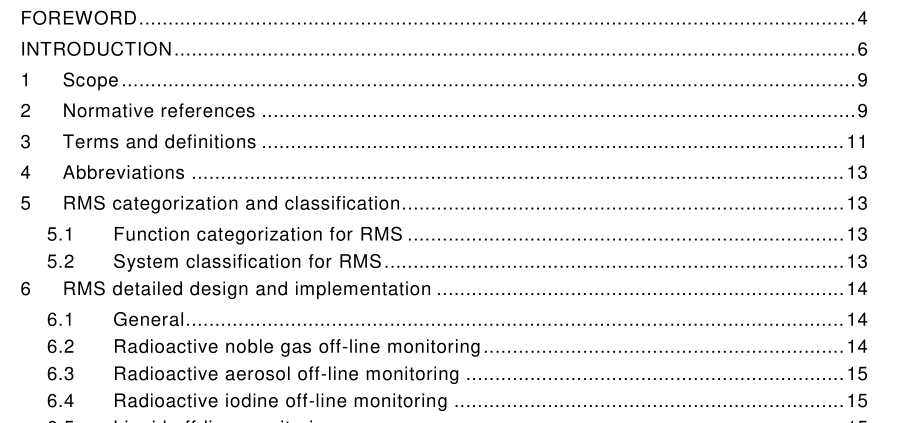IEC 62705-2014 pdf Nuclear power plants – Instrumentation and control important to safety – Radiation monitoring systems (RMS): Characteristics and lifecycle

5 RMS categorization and classification 5.1 Function categorization for RMS RMS in nuclear power plants provides continuous information about the radiological conditions in NPP by measuring the radiation levels in specific areas, on certain process lines and at gaseous and liquid release points. It provides alarms and can initiate automatic actions when the monitored radioactivity reaches levels that have been determined to be abnormal. The plant safety design base assigns the individual RMS functions important to safety into one of three categories A, B or C, considering the relationships to other systems to be connected. The main design requirements for the systems and equipment associated with these categories are consistent with those of Clause 7 of IEC 61 226:2009. The category shall be assigned during system requirement specification phase. 5.2 System classification for RMS RMS shall be classified according to its suitability to implement I&C functions up to a defined category during the system specification phase as shown in 6.2.3 of IEC 61 51 3:201 1 . Examples of the classification for RMS installed in PWR and BWR plants are shown in Annex A.
6.3 Radioactive aerosol off-line monitoring RMS for radioactive aerosol off-line monitoring is used for the following purposes: – to measure the volumetric activity of radioactive aerosols in gaseous effluents at the discharge point and the variation of volumetric activity. The monitor may also be used for the determination of the total discharge of radioactive aerosol over a given period; – to measure the volumetric activity in air or gas systems (control room ventilation, reactor leakage collection, drywell ventilation exhaust, fuel handling building ventilation exhaust, reactor building ventilation purge exhaust) and detect any significant increase of radioactivity. For RMS designed only for normal operation condition, the design and testing of RMS shall be performed in accordance with IEC 60761 -1 and IEC 60761 -2. For RMS designed for accident conditions, the design and testing of RMS shall be performed in accordance with IEC 60951 -1 and IEC 60951 -2. Sampling assembly for RMS used for this monitoring shall be designed and tested in accordance with ISO 2889. 6.4 Radioactive iodine off-line monitoring RMS for radioactive iodine off-line monitoring is used for the following purposes: – to measure the volumetric activity of radioactive iodines in gaseous effluents at the discharge point and the variation of volumetric activity. The monitor may also be used for the determination of the total discharge of radioactive iodine over a given period; – to measure the volumetric activity in air or gas systems (control room ventilation, reactor leakage collection, drywell ventilation exhaust, fuel handling building ventilation exhaust, reactor building ventilation purge exhaust) and detect any significant increase of radioactivity. For RMS designed only for normal operation condition, the design and testing of RMS shall be performed in accordance with IEC 60761 -1 and IEC 60761 -4.
- ISO IEC 27050-4-2021 pdf Information technology — Electronic discovery — Part 4: Technical readiness
- ISO IEC 27036-1-2021 pdf Cybersecurity — Supplier relationships — Part 1: Overview and concepts
- ISO IEC 27013-2021 pdf Information security, cybersecurity and privacy protection — Guidance on the integrated implementation of ISO/IEC 27001 and ISO/IEC 20000-1
- ISO IEC 26580-2021 pdf Software and systems engineering — Methods and tools for the feature- based approach to software and systems product line engineering
- ISO IEC 24735-2021 pdf Information technology — Office equipment — Method for measuring digital copying productivity
- ISO IEC 24711-2021 pdf Information technology — Office equipment — Method for the determination of ink cartridge yield for colour inkjet printers and multi- function devices that contain printer components
- ISO IEC 23544-2021 pdf Information Technology — Data centres — Application Platform Energy Effectiveness (APEE)
- ISO IEC 23510-2021 pdf Information technology — 3D printing and scanning — Framework for an Additive Manufacturing Service Platform (AMSP)
- ISO IEC 23127-1-2021 pdf Information technology — Learning, education, and training — Metadata for facilitators of online learning — Part 1: Framework
- ISO IEC 23126-2021 pdf Information technology for learning, education and training — Ubiquitous learning resource organization and description framework
- IEC 60183-2015 pdf Guidance for the selection of high-voltage A.C. cable systems
- ISO IEC 23126-2021 pdf Information technology for learning, education and training — Ubiquitous learning resource organization and description framework
- ISO IEC 26580-2021 pdf Software and systems engineering — Methods and tools for the feature- based approach to software and systems product line engineering
- IEC TR 63042-303-2021 pdf UHV AC transmission systems – Part 303: Guideline for the measurement of UHV AC transmission line power frequency parameters
- BS IEC 60860-2014 pdf Radiation protection instrumentation一 Warning equipment for criticality accidents
- BS ISO IEC 15420-2009 pdf Information technology一 Automatic identification and data capture techniques EAN/UPC bar code symbology specification
- BS ISO IEC 19762.5-2008 pdf Information technology一 Automatic identification and data capture (AIDC) techniques – Harmonized vocabulary Part 5: Locating systems
- BS IEC 60860-2014 pdf Radiation protection instrumentation一 Warning equipment for criticality accidents
- ISO IEC 24735-2021 pdf Information technology — Office equipment — Method for measuring digital copying productivity
- ISO IEC 24711-2021 pdf Information technology — Office equipment — Method for the determination of ink cartridge yield for colour inkjet printers and multi- function devices that contain printer components